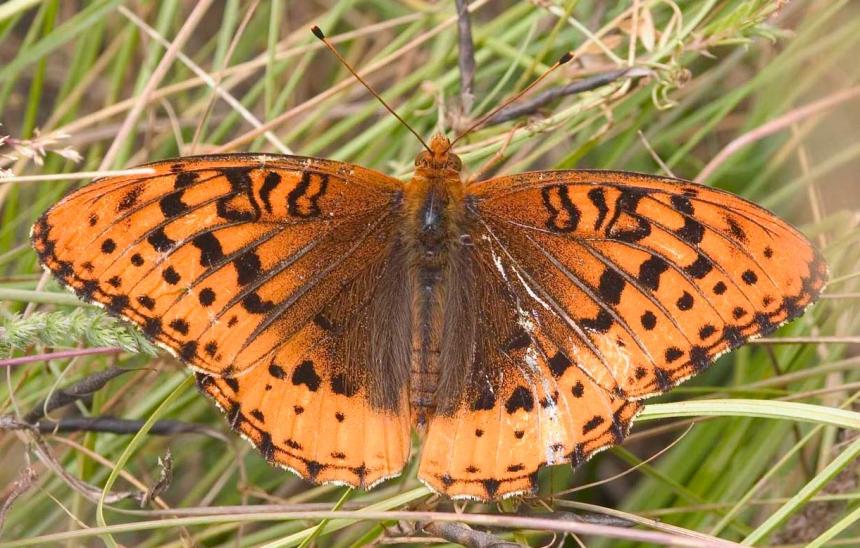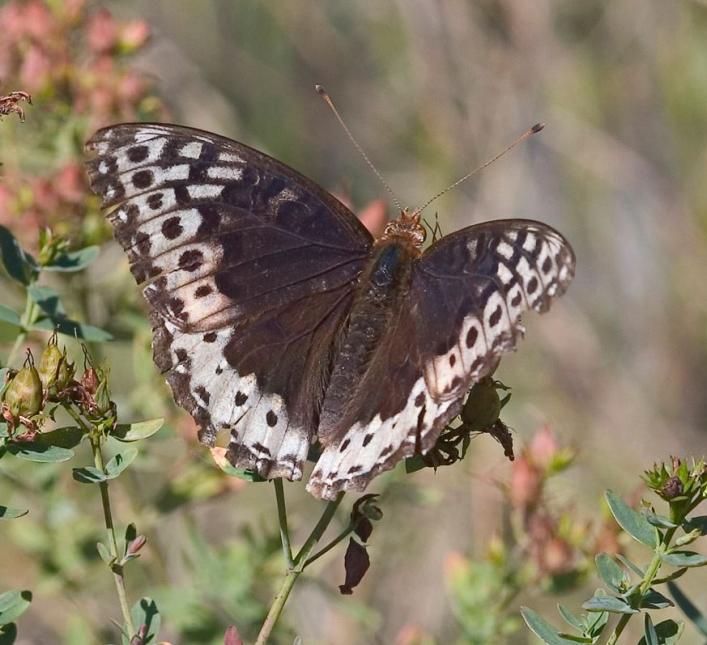Low-
Moderate
The population size of the Puget Sound fritillary in Washington is low and is considered to have a declining trend. The butterfly is recognized as a "Species of Greatest Conservation Need" in Washington due to its rare and restricted hostplants and habitat types, small number of isolated populations, limited range and distribution, and known threats to its habitats.
Description and Range
Physical description
The Puget Sound fritillary is in the genus Argynnis (greater fritillaries). They have a distinctive black line and dot patterning on their upperside wings—the males’s upperside is orange, and the female’s is dark brown with creamy bands along the outer edges. The underside of the wings is heavily-patterned with small, widely-spaced silvery orbs. Wingspan is up to about 3 inches. Fritillary larvae are generally dark with many bristled spines.
Ecology and life history
The Puget Sound fritillary relies on open habitats in western Washington where its host violets grow, including montane meadows in the northeastern Olympic Mountains, and low-elevation river and creek courses, forest openings, and native grasslands. Egg-laying has been observed in the south Puget Sound region on two violet species (Viola praemorsa and early blue violet, V. adunca). Adults require late-season nectar, and especially seek out native and non-native thistles (Cirsium). There have been no hostplant or habitat studies in Olympic Mountain populations.
Like other greater fritillaries, the Puget Sound fritillary complete a single life cycle annually (univoltine). They are sedentary butterflies and do not migrate; instead, the species inhabits sites year-round (as egg, larva, pupa and adult). Adults emerge from their chrysalids (pupae) during species-specific time periods; typically early-to-late summer.
Males begin emergence first, followed by females; late season individuals are primarily or solely females. Weather influences butterfly emergence and flight period duration, with wet or cold conditions potentially delaying emergence.
Male fritillaries seek mates using rapid patrolling and searching flight behavior. Females search for egg-laying sites by slowly flying and hovering above hostplants and then landing and crawling to inspect vegetation before depositing eggs singly.
Both males and females feed by using their long proboscis to sip floral nectar. Research on other Argynnis species suggests that nectar availability affects the number of eggs laid by females.
These species depend on violets (genus Viola) for their hostplants. Argynnis fritillaries lay eggs late in the summer. A tiny larva hatches within a few weeks and seeks shelter to overwinter, but does not feed until the following spring. The larvae feed nocturnally on their hostplants; this characteristic, along with bristled spines on their dark body and a gland that secretes defensive chemicals, protects larvae from predators.
Geographic range
The distribution of the Puget Sound fritillary is limited in part by their dependence on rare habitat types. Their distribution and abundance in Washington is characterized by low numbers of small isolated populations. Declines in both the number and size of populations have been documented for this species.
Overall, their range encompasses scattered populations in western Oregon, and the northeast Olympic Mountains and in southwest Washington. The species in Washington has been detected in the following counties: Clallam, Clark, Cowlitz, Lewis, Mason, Pierce, Skamania, and Thurston.
Surveys have been conducted to determine the distribution of this butterfly in the south Puget Sound region. Little is known of the current status and distribution of the species in other portions of their range within the state.
For a map of range-wide distribution status and conservation status of the Puget Sound fritillary, check out NatureServe Explorer.
Climate vulnerability
Sensitivity to climate change
Low-
Moderate
There is limited information on the sensitivity of the Puget Sound fritillary to climate change. Similar to other butterflies that occupy prairie and forest glade habitats, the Puget Sound fritillary is likely sensitive to fire, which can help prevent grassland succession to shrub or forest habitat, but can likely cause direct butterfly mortality and/or facilitate invasion and spread of invasive species.
Exposure to climate change
Moderate
- Altered fire regimes
Conservation
Conservation Threats and Actions Needed
- Invasive and other problematic species
- Threat: Invasive plants, those currently here, and many yet to come in the future, out-compete native grassland species, and otherwise make habitat unsuitable.
- Actions: Using herbicide, fire, and mechanical methods to restore native prairie. Planting/seeding native prairie species.
- Threat: Trees and shrubs encroaching on habitat in forest matrix sites throughout the butterfly’s range, due to long-term fire suppression
- Action Needed: Remove invading trees and shrubs.
- Resource information collection needs
- Threat: Incomplete knowledge of this species' distribution in the northeast Olympic Mountains.
- Action Needed: Conduct surveys to determine current status and distribution of populations, primarily needed on the Kitsap Peninsula and northeast Olympic Peninsula.
See the Climate vulnerability section for information about the threats posed by climate change to this species.
Resources
References
Boggs, C. 2003. Environmental variation, life histories, and allocation in Butterflies: Ecology and Evolution Taking Flight. Boggs, C., W. Watt, and P. Ehrlich, eds. The University of Chicago Press. 737pp.
Hays, D., A. Potter, C. Thompson, and P. Dunn. 2000. Critical habitat components for four rare south Puget Sound butterflies. Final report to The Nature Conservancy. Washington Department of Fish and Wildlife. Olympia.
James, D. and D. Nunnallee. 2011. Life Histories of Cascadia Butterflies. Oregon State Univ. Press, Corvallis. 447pp.
Pyle, R.M. and LaBar, C.C. 2018. Butterflies of the Pacific Northwest. Timber Press. 461 pp.
Pyle, R. 1989. Washington butterfly conservation status report and plan. WDFW, Olympia. 216pp.
Schultz, C., E. Henry, A. Carleton, T. Hicks, R. Thomas, A. Potter, M. Collins, M. Linders, C. Fimbel, S. Black, H. Anderson, G. Diehl, S. Hamman, R. Gilbert, J. Foster, D. Hays, D. Wilderman, R. Davenport, E. Steel, N. Page, P. Lilley, J. Heron, N. Kroeker, C. Webb, and B. Reader. 2011. Conservation of prairie-oak butterflies in Oregon, Washington, and British Columbia. Northwest Science 85: 361–388.
Zhang, J., Q. Cong, J. Shen, P. A. Opler and N. V. Grishin. 2020. Genomic evidence suggests further changes of butterfly names. The Taxonomic Report of The International Lepidoptera Survey 8(7):1-41.

